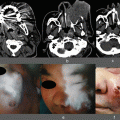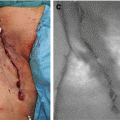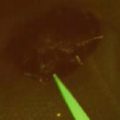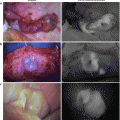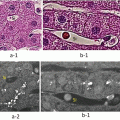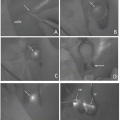Fig. 25.1
Near-infrared fluorescence imaging system. Photodynamic eye has a single monochrome charge-coupled device (CCD) and outputs gray-scale images (a). HyperEye Medical System has a single CCD that has red, green, blue, and infrared filters and can output gray-scale and color plus infrared images (b)
PDE irradiates the NIR wavelength of 760 nm by using a red light-emitting diode (LED) and band-pass filter, and the emission peak at the wavelength of 830 nm is observed through the long-wave pass filter and a single monochrome charge-coupled device (CCD) with high sensitivity in NIR waves.
HEMS also irradiates the NIR wavelengths of 760 nm and detects the NIR wavelengths of 830 nm as well as the PDE does. Different from the PDE, HEMS has a single special CCD image sensor that has red, green, and blue filters and also an infrared filter that enables detection of both visible and NIR radiation simultaneously and outputs real-time color and NIR imaging.
25.3 Techniques of ICG Injection for Intraoperative Liver Segmentation
There are two ways to perform ICG injection for intraoperative liver segmentation. One is the counterperfusion method and the other is the direct perfusion method.
25.3.1 Counterperfusion Method
The counterperfusion method is based on the Glissonian approach [7]. The procedure of the counterperfusion method is as follows. First, the Glissonian sheath is dissected from the liver parenchyma toward the tumor-bearing Glissonian pedicle from the hilar plate and encircling the Glissonian pedicle (Fig. 25.2a). Next, ligation is performed or a tourniquet is placed, and blood inflow of the planned resection area is occluded (Fig. 25.2b). After that, the surface of the inflow-occluded area becomes ischemic. However, when a patient has a cirrhotic liver, the ischemic change is sometimes unclear (Fig. 25.2c). Then, ICG water solution (1 mL of 2.5 mg/mL) is intravenously injected. The NIRF imaging can be observed approximately 20 s after ICG injection. The blood perfusion area, namely, the remnant hepatic segment, gradually emits ICG fluorescence. Therefore, the planned resection area, where the inflow is occluded, is observed as the nonfluorescent area (Fig. 25.2d).
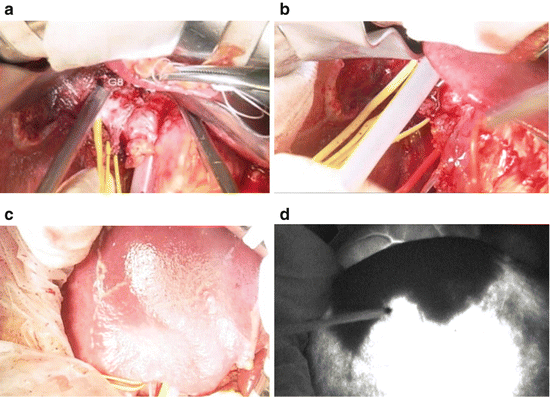

Fig. 25.2
The procedures of counterperfusion method are shown (a case of segment VIII resection). The Glissonian branch of segment VIII (G8) was dissected from the hilar plate (a). G8 pedicle was clamped (b). Segment VIII became ischemic, but it is not clearly visible (c). After peripheral venous injection of 1 mL ICG water solution (2.5 mg/mL), segment VIII was clearly depicted by NIRF imaging (d)
25.3.2 Direct Perfusion Method
The direct perfusion method is performed in the same way as the indigo carmine dye staining method [6]. If a targeted Glissonian pedicle is far from the hilar plate and the counterperfusion method is technically difficult, then this procedure is applied. The procedure is as follows: directly puncture the target portal vein pedicle with a 23- or 21-gauge needle under IOUS guidance. We puncture approximately 1 cm distal from the target Glissonian pedicle to avoid ICG from straying to some other portal vein branches. Next, 1 mL of 5 mg/mL ICG water solution is injected slowly [16]. Immediately after the ICG injection, the Pringle maneuver is performed to prevent ICG from going away from the liver parenchyma. After that, the NIRF image is observed. In this method, contrary to the perfusion method, the planned resection area shows fluorescence of ICG (Fig. 25.3).
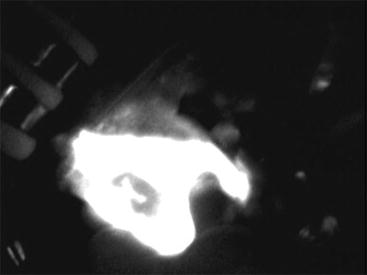

Fig. 25.3
The fluorescent image of direct perfusion method is shown (a case of segment VI resection). Immediately after direct injection of 1 mL ICG water solution (5 mg/mL) to the target portal vein, the planned resection area showed fluorescence
25.4 Imaging Results
25.4.1 Images of the Counterperfusion Method During Liver Resection
We show images of right anterior sectionectomy using this counterperfusion method with the HEMS camera system (Fig. 25.4a–d). After completion of the Pringle maneuver and the Glissonian approach, the Glissonian pedicle of segments V and VIII was encircled and clamped during the entire surgery. After 1 mL of 2.5 mg/dL ICG water solution was injected intravenously, the NIRF images were observed by using the HEMS camera system. Approximately 60 s after injection, fluorescence had maximum intensity and clearly depicted the planned resection area (Fig. 25.4a). Based on this fluorescent borderline, liver resection was performed. During liver resection, the NIRF image was observed repeatedly, and the resection line or transection plane could be visually checked (Fig. 25.4b). After resection, we could confirm that the resection was performed as planned by observing fluorescence on the cut surface (Fig. 25.4c). When there is a part that does not show fluorescence on the cut surface, then this indicates that the resection might not have been performed as planned, because the nonfluorescent lesion would be a part of a planned resection area (Fig. 25.4d).
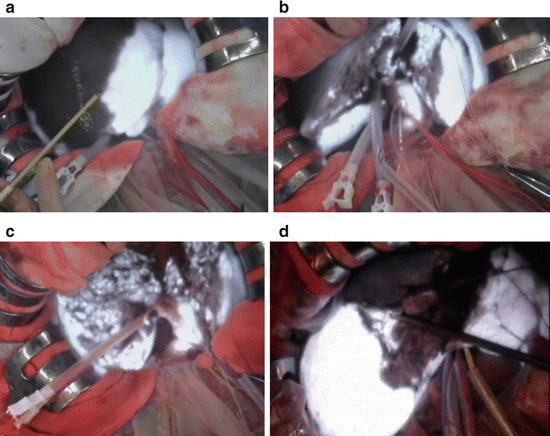

Fig. 25.4
Images of right anterior sectionectomy are shown. The right anterior section was shown as the nonfluorescent area (a). During parenchymal resection, the fluorescence was maintained (b). If resection is performed as planned, then the fluorescence can be observed on the cut surface (c). If not, then the nonfluorescent portion would remain on the cut surface (d)
25.4.2 Images of the Direct Staining Method During Liver Resection
An image of the segment VI resection using direct perfusion method is shown (Fig. 25.5). Immediately after ICG injection, segment VI emitted strong fluorescence. Because blood inflow was occulted by the Pringle maneuver, ICG remained in segment VI and maintained fluorescence during the Pringle maneuver. Under this Pringle maneuver, we could resect the liver parenchyma while observing fluorescence on the cut surface of the removal side.
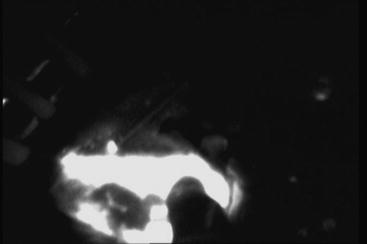

Fig. 25.5
A fluorescent image of segment VI resection using direct perfusion method is shown. Segment VI was depicted as the fluorescent area. Under the Pringle maneuver, the area of segment VI was marked using electrocautery and resected.
25.5 Discussion
Liver anatomy that divides the hepatic parenchyma into segments I to VIII based on the branching form of the Glissonian pedicle is familiar worldwide and is recognized as Couinaud’s segmentation. Using Couinaud’s segmentation, liver surgeons visualize the existing tumor area and proposed anatomical resection. In addition, because three-dimensional intrahepatic vascular anatomy reconstructed by contrast-enhanced multi-detector row CT images has been easily acquired, precise simulation of anatomical resection could be achieved [20, 21].
In this chapter, we present counterperfusion and direct perfusion methods using novel NIRF imaging with ICG injection for detecting liver segmentation intraoperatively. Hemihepatectomy or left lateral sectionectomy will not always need this NIRF imaging because of its simple cut plane. However, right anterior, right posterior, and left medial sectionectomy, segmentectomy, and anatomical resection less than segmentectomy, which are sometimes complicated in the cut plane, will benefit from these novel methods. Because the counterperfusion method requires dissection of the hilar plate, right anterior, right posterior, and left medial sectionectomy would be suitable for this method. However, resection of segment V, VI, VII, or VIII, during which it is sometimes technically difficult to encircle the root of the Glissonian pedicle, will be favorable for the direct perfusion method.
Conventionally, the Glissonian approach and dye staining method have been useful for detecting segments of the surface of liver parenchyma [7, 6]. Although surgical approaches for these conventional methods are similar to those of our novel methods, imaging results are completely different.
Stay updated, free articles. Join our Telegram channel

Full access? Get Clinical Tree


